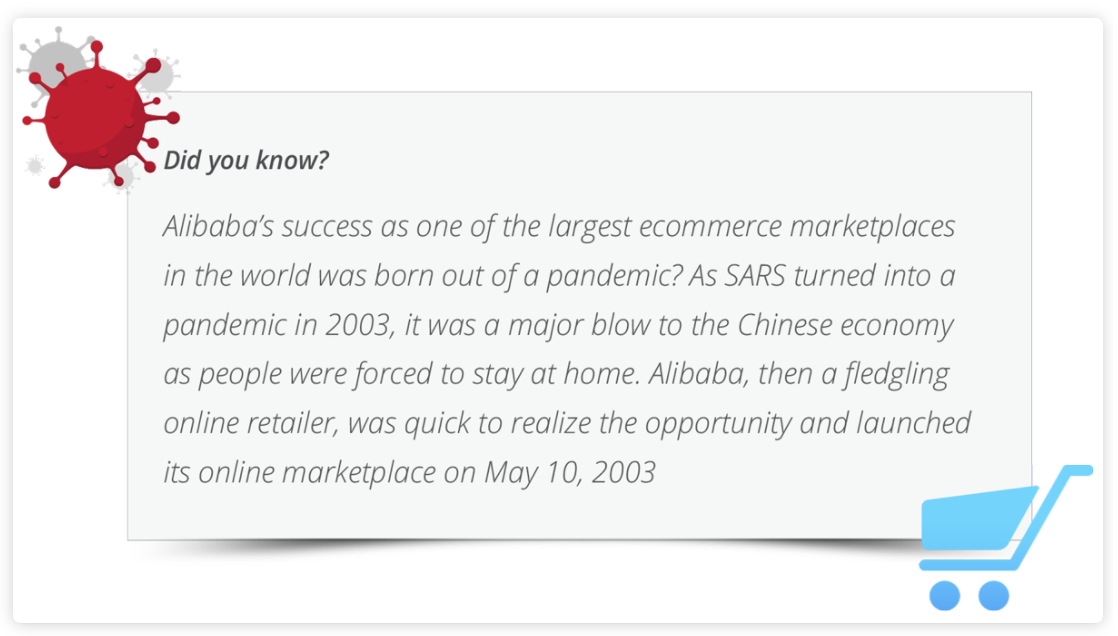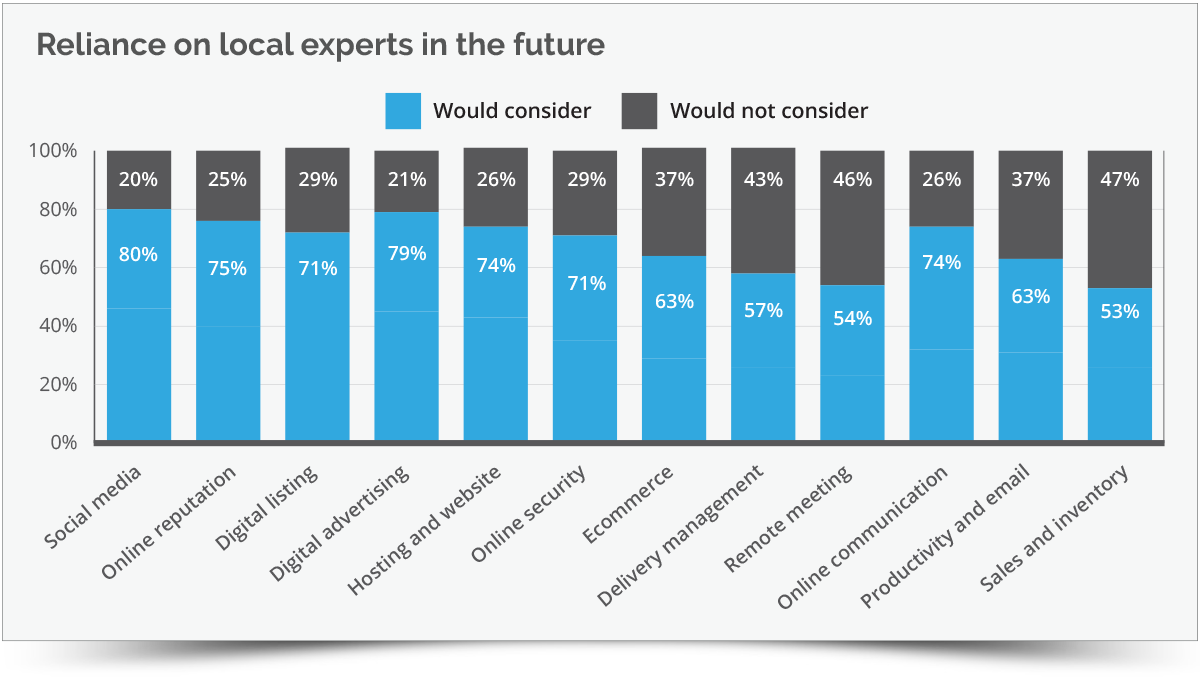What are the roadblocks to ecommerce adoption by small businesses?
COVID-19 has seen a dramatic rise in ecommerce activities. The share of ecommerce in total global retail sales jumped 13.6 percent in 2019 to 18 percent in 2020, and expected to touch 21.8 percent by 2024. That’s a well-known story now. But did you know that one in three small businesses in the United States are still closed as compared to January 2020? Or that every third small business in Canada reported drop in revenues in 2020 as compared with the previous year?
“Small-and medium-sized businesses are the backbone to our economy. But 34 percent of SMBs in the U.S. remain closed while many large retailers are setting record-breaking sales. So, it sure doesn’t feel like a recovery to me – as if we are all in this together,” says Vendasta CEO Brendan King.
Read this blog on What is Amara’s Law and How is it Relevant to Ecommerce
As the pandemic accelerated the shift away from physical stores to digital shopping, many small businesses who had been late to ecommerce adoption were left scrambling to survive. This is especially true for local small businesses who have never experimented with anything digital beyond accepting a PayPal payment.
So what are some of the roadblocks to ecommerce adoption by SMBs?
Lack of understanding of the digital world
Most small businesses, such mom-and-pop stores who catered to their locality, never had the need to go digital. In fact, in the United States, only 64 percent of small businesses have their own website, according to the Small Business Administration. The scenario is often worse in other markets.
Sadly, it’s a do or die for them now. As George Leith, Vendasta’s chief customer officer, puts it, “If businesses don’t adapt to digital now, they may not survive the journey in the long road ahead. The pandemic is a catalyst for businesses to make the switch to digital.”
Understanding of consumer preference
Even before the pandemic, consumers are increasingly dependent on digital devices to access information. A pre-COVID study by Blue Corona found that 80 percent of customers will research a company online before visiting it. Similarly, a Stanford University study revealed that customers will judge a company’s credibility by its website design.
While a large percentage of potential customers use smartphones for checking out products they might buy, in 2018 only 81 percent of SMB websites were mobile friendly. Similarly, nearly half of Google searches have local intent, highlighting the need for appearing at the top of search results pages. Local business owners who have catered to a specific clientele and relied on word-of-mouth, do not fathom how fast consumer preferences and habits change.
Want to know How to Optimize Google Business Profile for Local SEO? Read this blog
Legacy and mindset issues
Most small businesses have historically sold offline. A huge number of business owners are on the cusp of retirement now. There is a generational shift going on where many businesses that have been founded in the last decade are more tech savvy and deploying technology much more efficiently. While some legacy businesses had limited online presence, many did not aggressively develop digital commerce.
Going forward there needs to be tighter integration between online and offline – online booking, offline fulfillment, online payments, and so forth.
“Local businesses should see ecommerce adoption as just another way to provide value to their customers, and they should recognize that there’s going to be a lot of diversity among them,” says Shane Schick, journalist and B2B content marketing expert. “Some might become online-only, for instance, while others will continue to prefer shopping in person, or use a mix of the two approaches. The experience should be consistent no matter which way customers choose to interact,” he adds.
Lack of resources
Running a small business is always tough. Many operate with limited financial and people resources. They are often family run and have limited digital acumen and available capital. A pre-COVID survey from The Manifest and Smart Insights revealed that more than 25 percent of social-media marketers say a shortage of resources is the biggest obstacle for small businesses to adopt a successful social media plan.
Learn How to Sell Online in 2021: 10 Tips for Small Businesses Getting Started with Ecommerce
Advancements in technology
Fierce fighting in the digital realm poses tremendous challenges to small retailers, the pandemic notwithstanding. Ecommerce adoption is more than simply setting up a website and waiting for orders. It needs search engine optimization (SEO), targeted social media activities and monitoring, management of listing and reviews, and much more.
“For the longest time, channel marketing was the poor relative of all marketing branches, cookie-cutter campaigns and activities, and little focus was placed on the end customer experience. Meanwhile, the B2B landscape is shifting dramatically, and buyers now expect high-quality digital services when making a B2B purchase,” points out CX Atelier Founder Ayan Adam.
Find out What are MSP Marketing Challenges and Six Ways to Fix Them
Factors influencing ecommerce adoption
In June 2020 global retail ecommerce traffic hit a record 22 billion monthly visit. A year later, as the world struggles to contain the spread of the virus and new variants, online shopping remains an important and vital retail option.
The pandemic accelerated the shift away from physical stores to digital shopping by roughly five years, according to IBM’s U.S. Retail Index. As lockdowns and physical distancing norms forced the shutdown of in-store retail – albeit temporarily but repeatedly – big brands to small local businesses scrambled to switch to digital. For many small businesses, who relied completely on storefront traffic, this was a daunting task. For many, digital marketing/sales agencies became a vital resource.
However, it wouldn’t be right to call the pandemic the only driving factor. The ecommerce industry was fast becoming an indispensable part of the global retail ecosystem, thanks to the ongoing digitalization.
Internet penetration: Approximately 4.72 billion people around the world use the internet or more than 60 percent of the total global population – and it’s growing at a compounded annual growth rate (CAGR) of 7.6 percent. Internet accessibility gives shoppers ease of access and choice in various online platforms to browse, compare, and purchase items or services they need.
Availability of smartphones: More than 67 percent of the global population uses a mobile phone, with smartphones accounting for three-quarters of all mobile handsets in use today. An overwhelming majority (92.8 percent) use mobile phones to access the internet, while smartphones accounted for more than 60 percent of all retail website visits worldwide in 2019.
Rise of Amazon and Alibaba: From an online bookstore to one of the leading companies on the planet, Amazon’s rise is what makes up legends. But that’s a different story for a different day. Suffice to say here, it was the global trendsetter for ecommerce and we couldn’t have had the boom in the sector had it not been for Amazon. It is leading the global ranking of online retail websites in terms of traffic, and its 2017 market share of the US ecommerce retail market was 37 percent, which is expected to increase significantly by 2021. However, in terms of gross merchandise value (GMV), Amazon comes third behind China’s Taobao and Tmall – both owned by the Alibaba Group, which leads due to its online footprint across Asia.
SMBs need help from local experts
Post-COVID, the impact of the shift to digital has been varied.
- Online-only retailers faced little or no disruption, other than in sectors such as hospitality, travel, and tourism.
- Traditional retailers who had established online offerings were better placed to deal with the challenge as physical stores closed.
- Many offline-only businesses were quick to pivot, at times within a week, and move online to meet changing customer requirements.
- Businesses that remained wholly offline were the worst hit, whether by enforced lockdowns or lower footfall due to customer hesitation.
Of course, SMBs can’t do everything on their own. There exists a set of specialists, or local experts, whom SMBs can enlist to provide the right solutions for their fast-changing needs. According to the Vendasta State of Local Businesses 2021 survey, the pandemic drove many businesses to turn to local experts to help them adopt new digital solutions.
Key findings include:
- 35 percent of local businesses that did not utilize expert service earlier have relied on them since the pandemic
- 80 percent of respondents would consider looking to local experts in the future to purchase/manage social media marketing tools
- 79 percent would consider local experts for digital advertising
- 76 percent for online reputation
- 71 percent for listing management
These local experts include marketing and advertising agencies, independent software vendors (ISV), value added resellers (VARs), managed service providers (MSPs), IT Solution Provider (ITSP), and managed security service providers (MSSPs). There are distinct differences between each of these traditional service providers, but the lines are fast blurring.
The way forward
Regardless of the exact kind of the services they provide, there has never been a better time to be a local ecommerce and digital marketing and sales expert, providing local businesses with the solutions they need to succeed now and in the future.
As Accenture notes in its Powering SMB Resiliency in a COVID-19 World, the emphasis for digitally mature SMBs should be to expand their reach through offerings like social listening, 24/7 help desk functions, digital assistants, video chats, tutorials and webinars, and online community groups.
“Businesses that can leverage remote workers, have a SaaS (software-as-aservice) infrastructure, and can sell stuff online, are more nimble and less intimidated by technology are going to be the ones that ultimately survive and thrive,” says Greg Sterling, vice president of market insights at Uberall.
With online demand likely to remain strong in a post-pandemic world – a Salesforce survey finds 61 percent of consumers saying they will do even more online shopping after the pandemic than they did before – retailers must adapt to a “new normal.” Ecommerce adoption for SMBs is no longer simply a nice-to-have. As it is for big businesses, the online model is essential for SMBs, too.






